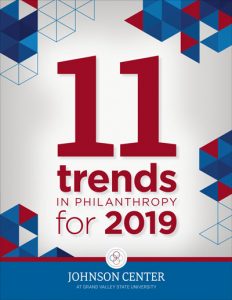Concrete Strategies Are Emerging for Implementing Diversity, Equity, and Inclusion Principles


 The philanthropic sector has historically played a major role in advancing social justice. Philanthropists and nonprofit organizations form the bedrock of our communities, addressing the challenges of housing, feeding, clothing, educating, healing, and supporting community members. However, today, the challenges are greater and more complex, attributable in part to significant demographic shifts and rising expectations for employees’ educational attainment.
The philanthropic sector has historically played a major role in advancing social justice. Philanthropists and nonprofit organizations form the bedrock of our communities, addressing the challenges of housing, feeding, clothing, educating, healing, and supporting community members. However, today, the challenges are greater and more complex, attributable in part to significant demographic shifts and rising expectations for employees’ educational attainment.
In addressing these complex challenges, we are seeing more robust, transformative efforts from philanthropy to establish truly inclusive communities. Operationalizing the principles of diversity, equity, and inclusion (DEI) in social sector work is critical to creating a more equitable society.
Some of these concrete strategies are already taking shape: activities to establish diverse talent pipelines for foundations and nonprofit organizations, exploring inclusive economy models in our communities as a strategy for growth, and the application of more equitable evaluation practices within foundations and nonprofit organizations as they measure outcomes and impact.
In recent years, data and information have called attention to the reality that the philanthropic sector lacks diversity in its workforce and among its board membership. Evidence of this is documented in many reports and articles from D5 Coalition (Chandler, Quay, & Martinez, 2014), Board Source (2017), GrantCraft (Bartczak, 2018), Independent Sector (Brennan, 2018), Fund the People (2017), and others.
Funders are beginning to positively change this narrative and address the deficit of diverse human capital investment in both their own and the nonprofit workforce. They are providing incentives, resources, and skills to build teams that reflect, understand, and represent our diverse communities. Their continued attention to this is imperative.
Inclusive growth in our communities, also known as an inclusive economy, occurs when all people in the community share in the benefits of economic growth. There are efforts in the nonprofit sector to make this an intentional strategy in our cities and regions (Shearer & Berube, 2017).
“Inclusive growth in our communities … occurs when all people in the community share in the benefits of economic growth. There are efforts in the nonprofit sector to make this an intentional strategy in our cities and regions.”
The United States has long been known as a “land of opportunity” where anyone, regardless of background, could prosper. More recent data and research on upward mobility tells us that the U.S. is actually lower than many other countries in mobility achievement (Chetty, 2016). Given the complexity of this issue, initiatives promoting inclusive growth are calling for community-wide partnerships among nonprofits, the private sector, and government to work under a guiding set of principles for equitable development. These efforts are building a modern economy that advances all people (Rubin, Blackwell, Schildt, 2016).
Champions of equitable evaluation believe that equity should be incorporated into the evaluation process that grantmakers use to review the effectiveness of the work their grantees are engaged in. The equitable evaluation premise challenges many of the fundamental principles of “good” evaluation practices and insists that grantmakers will need to reconsider their core beliefs around evaluation in order to incorporate equity into their evaluative process (Equitable Evaluation Initiative, 2017).
Those who advocate for equitable evaluation methods believe that the paradigm must change in order to shape how we learn about our communities, programs, and practices. This model should be a call to action.
All three of these efforts are examples of the nonprofit sector’s commitment to deeper exploration in operationalizing DEI principles. These explicit elements are supporting a more diverse workforce, new frameworks for ensuring prosperity for all people, and new expectations for programmatic success. The nonprofit sector continues to find new ways to be a catalyst and strategic partner with others in establishing these new paradigms.
Bartczak, L. (2018, November 1). Advancing racial equity through capacity building: The Kresge Foundation’s talent and leadership development efforts. Retrieved from http://grantcraft.org/content/case-studies/advancing-racial-equity-through-capacity-building/
BoardSource. (2017). Leading with intent: 2017 national index of nonprofit board practices. Retrieved from https://leadingwithintent.org/wp-content/uploads/2017/11/LWI-2017.pdf
Brennan, J. (2018, June 7). The latest DEI research. Retrieved from https://independentsector.org/news-post/the-latest-dei-research
Chandler, A., Quay, L., & Martinez, T. E. (2014). Philanthropic Paths: An exploratory study of the career pathways of professionals of color in philanthropy. Chicago, IL: D5 Coalition. Retrieved from http://www.d5coalition.org/wp-content/uploads/2014/05/Philanthropic-Paths.pdf
Chetty, R. (2016). Socioeconomic mobility in the United States: New evidence and policy lessons. Shared prosperity in America’s communities. Philadelphia, PA: University of Pennsylvania Press.
Equitable Evaluation Initiative. (2017, August 1). EE Inaugural Roundtable – 30+ Gathered on August 1st. Retrieved from https://www.equitableeval.org/blog-main/2017/8/9/ee-inaugural-roundtable-30-gathered-on-august-1st
Fund the People. (2017). Equity and Inclusion: Invest in Equity Inside the Nonprofit Workforce. Retrieved from http://fundthepeople.org/toolkit/wp-content/uploads/2018/02/EquityAndInclusionCollection.pdf
Rubin, V., Blackwell, A.G., & Schildt, C. (2016). Equitable and inclusive growth strategies for American cities. Shared prosperity in America’s communities. Philadelphia, PA: University of Pennsylvania Press.
Shearer, C., & Berube, A. (2017, April 27). The surprisingly short list of US metro areas achieving inclusive economic growth [blog post]. Retrieved from https://www.brookings.edu/blog/the-avenue/2017/04/27/the-surprisingly-short-list-of-u-s-metro-areas-achieving-inclusive-economic-growth/